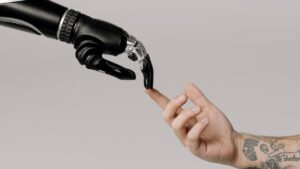The Genesis of IoT: More Than Just Smart Gadgets

You’ve heard the term before: Internet of Things, or IoT. It sounds complex, but when you break it down, it’s not that complicated. Imagine your morning coffee machine ‘talking’ to your alarm clock, so you have a steaming cup ready as soon as you wake up. This is IoT at its simplest. It’s all about devices—anything with an on/off switch—communicating with each other through the internet. IoT and AI go hand in hand.
Table 1: Examples of Everyday IoT Devices
| Device | Function | Impact on Daily Life |
|---|---|---|
| Smart Thermostat | Controls home temperature remotely | Energy Efficiency, Cost Saving |
| Fitness Tracker | Monitors physical activities | Health Monitoring |
| Smart Fridge | Keeps track of grocery levels | Reduced Wastage, Convenience |
| Connected Car | Real-time analytics and feedback | Safer Driving, Energy Efficiency |
IoT and AI: A Marriage Made in Data Heaven
Now, let’s introduce AI (Artificial Intelligence) to this equation. AI gives these devices the ability to think, learn, and make decisions. Your smart fridge could not only tell you what you’re running out of but also order groceries for you. How does it know what to order? By learning from your past behavior and preferences. It’s as if the fridge has its own little ‘brain,’ thanks to AI.
The data from IoT devices provides the raw material that AI algorithms need to learn and make better decisions.
According to DataProt,
- In 2021, there were more than 10 billion active IoT devices.
- It’s estimated that the number of active IoT devices will surpass 25.4 billion in 2030.
- By 2025, there will be 152,200 IoT devices connecting to the internet per minute.
- IoT solutions have the potential to generate $4-11 trillion in economic value by 2025.
- 83% of organizations have improved their efficiency by introducing IoT technology.
- It’s estimated that global IoT spending will total $15 trillion in the six-year period between 2019 and 2025.
- The consumer IoT market is estimated to reach $142 billion by 2026 at a CAGR of 17%.
- 94% of retailers agree that the benefits of implementing IoT outweigh the risk.
- The amount of data generated by IoT devices is expected to reach 73.1 ZB (zettabytes) by 2025.
Real-world Case Study 1: Smart Cities

Take Singapore, for example. This city-state is on the forefront of developing a ‘Smart Nation’ powered by both IoT and AI. Traffic cameras and sensors placed all around the city gather data about traffic flows, pedestrian movements, and public transportation. AI algorithms then crunch this data to control traffic lights, optimize bus routes, and even predict maintenance needs for public infrastructure. This leads to less congestion, reduced pollution, and a smoother life for its citizens.
So, how is this blend of IoT and AI changing the game for us? How does it make our lives better or worse?
IoT: A Double-Edged Sword
For all its merits, IoT has its drawbacks. The more devices connected to the Internet, the more vulnerabilities we open ourselves to. Remember, anything that’s connected can be hacked. In 2016, a distributed denial of service (DDoS) attack took down major websites like Twitter and Netflix, by infecting millions of IoT devices.
Real-world Case Study 2: Health Tech Risks

In the health sector, IoT devices like insulin pumps or heart rate monitors can be life-saving. But what happens if these devices are compromised? The FDA has already identified potential vulnerabilities in such devices and is pushing for more robust cybersecurity measures.
So, what are the ethical considerations in ensuring the safety and security of interconnected devices?
The Sanctity of Data: Security in an IoT World
Before we dive into the nitty-gritty, let’s talk about something fundamental: data sanctity. Data is the lifeblood of both IoT and AI. It’s what makes everything ‘smart.’ However, this very data can be a goldmine for hackers. As more and more devices get connected, ensuring the sanctity and security of this data becomes critical.
Table 2: IoT Security Measures and Their Importance
| Security Measure | Objective | Impact on Data Sanctity |
|---|---|---|
| Encryption | Scramble Data | Protects data from unauthorized access |
| Multi-Factor Authentication | Confirm User Identity | Limits access to authorized personnel |
| Regular Updates | Fix Vulnerabilities | Keeps the system secure over time |
| Network Monitoring | Detect Anomalies | Enables quick response to threats |
Balancing Innovation with Caution
It’s human nature to forge ahead, to innovate. But with great power comes great responsibility. Companies are often in a rush to get their IoT products to market, sometimes sacrificing security measures. In such a scenario, the role of AI is not just to facilitate but to protect. AI can detect anomalies or suspicious activities on the network, effectively acting as a watchdog.
The Role of AI in IoT Security

Remember, AI doesn’t just enable better services; it also offers better security. Advanced AI algorithms can detect unusual patterns and potential security threats, thereby allowing for real-time responses. This can mitigate or even prevent cyber-attacks, safeguarding the sanctity of user data.
According to a report by Cybersecurity Ventures, cybercrime damages could cost the world $10.5 trillion annually by 2025. AI can significantly lower this number by adding an extra layer of security. The importance of integrating AI into IoT is therefore not just a matter of convenience but of necessity.
Regulatory Measures and Standards
How do we ensure that this new frontier of technology adheres to norms and standards that prioritize human safety and data sanctity? The answer lies in regulation. Agencies like the Federal Trade Commission (FTC) in the United States are pushing for standardization in IoT security. These bodies encourage transparency, consumer choice, and data minimization to ensure the sanctity of data.
Table 3: Regulatory Bodies and Their Roles
| Regulatory Body | Role | Impact on IoT and AI |
|---|---|---|
| FTC | Consumer Protection | Sets guidelines for data storage and privacy |
| FDA | Health and Safety | Ensures medical IoT devices meet safety standards |
| FCC | Communication Standards | Regulates IoT data transfer and bandwidth use |
How does regulation affect the rapid development and deployment of IoT and AI technologies? And what role does Sanctity AI play in this landscape?
The Cost of Connectivity: Environmental Implications

While we’re enchanted by the benefits of IoT and AI, it’s essential to consider the environmental toll. Data centers, running 24/7, consume vast amounts of energy and water. How do we reconcile the growing need for data storage and processing with our responsibility to the planet?
Greener Alternatives: The Role of AI
In an interesting twist, AI may be part of the solution. Advanced algorithms can optimize energy use in data centers, reducing their carbon footprint. Google, for instance, used its DeepMind AI to cut data center cooling costs by 40%. AI can also be used to create “smart grids” for electricity, optimizing energy distribution to reduce waste.
Ethical AI: Forging a Sustainable Future
Let’s not forget the role of ethics in this arena. It’s not enough to make our lives convenient. We need to consider the long-term impact on society and the planet. Sanctity AI believes in responsible AI usage, and part of that is ensuring sustainability.
The Social Contract: Public Perception and Trust

We need to discuss the elephant in the room: trust. Public opinion about IoT and AI ranges from cautious optimism to outright fear, especially in the wake of high-profile data breaches and privacy concerns.
Table 4: Public Perception of IoT and AI
| Factor | Public Opinion | Influence on Adoption |
|---|---|---|
| Data Privacy | High Concern | Potential Hurdle |
| Device Security | Mixed Feelings | Slows Adoption Rate |
| Environmental Impact | Growing Awareness | Ethical Considerations |
Building Trust: Transparency and User Control
The key to widespread adoption is building trust. This is where transparent business practices and clear regulations come in. Users need to know their data is safe, secure, and being used responsibly. By giving users control over their own data, we uphold the principle of data sanctity, fostering a healthier relationship between people and technology.
IoT and AI in Developing Countries
While developed nations have been quick to adopt IoT and AI, developing countries are not far behind. These technologies have the power to solve critical issues like healthcare accessibility, food security, and education. Projects like IBM’s Watson have made strides in assisting healthcare professionals in remote areas.
But these opportunities come with their own set of challenges. Infrastructure limitations, data privacy concerns, and the ethical use of AI are pressing issues. These countries may not have robust regulatory frameworks to safeguard data sanctity and ensure responsible AI use.
So, what challenges do developing countries face in adopting IoT and AI, and how can they ensure the sanctity and ethical use of these technologies?
The Digital Divide: Bridging Gaps and Creating Opportunities
The technological advancements in IoT and AI are undoubtedly groundbreaking, but there’s a caveat. We risk creating a digital divide where only those with access to high-speed internet and cutting-edge devices can benefit from these innovations.
Inclusivity: A Core Tenet of Sanctity AI
Sanctity AI advocates for an inclusive approach where technology serves everyone, irrespective of socio-economic status. Governments and organizations can leverage IoT and AI to provide better healthcare, education, and essential services to underserved communities.
Case Studies: Real-World Applications that Uphold Data Sanctity
- Smart Agriculture: Companies like John Deere use IoT sensors and AI algorithms to optimize farming techniques, minimize waste, and increase yield.
- Telemedicine: Remote healthcare has seen significant improvement thanks to IoT medical devices and AI algorithms that can diagnose conditions early, often in places where medical facilities are scarce.
The Sanctity of Human Experience: Accessibility and Usability

As we blend the physical and digital worlds, we must ensure that these technologies are accessible. User-friendly interfaces, adaptive learning algorithms, and robust security measures are not just optional features but necessities to uphold the sanctity of the human experience.
Conclusion: Navigating the Intersection of IoT and AI
The confluence of IoT and AI presents unprecedented opportunities and challenges. The possibilities are limitless, from smart cities to personalized healthcare. But with these advancements come concerns—data privacy, environmental impact, and social implications—that we must address proactively.
Importance of the Sanctity of AI
The guiding principle of Sanctity AI is to build a world where AI usage is safe, reliable, responsible, and inviolable. The intersection of IoT and AI opens avenues that can either empower humanity or lead to unwarranted consequences. Ensuring the sanctity of AI is not just an ethical obligation but a necessity for a harmonious future.
So, are we prepared to navigate this intricate web of innovation and ethics to build a future that safeguards the sanctity of human life and data?
Frequently Asked Questions (FAQs)
What are the key security vulnerabilities in IoT?
- Weak Authentication: Poorly secured passwords and lack of multi-factor authentication expose devices to hacking.
- Insecure Networks: Data can be intercepted during transmission if network security is compromised.
- Outdated Software: Devices running on outdated firmware are susceptible to attacks.
How does AI improve IoT security?
- Anomaly Detection: AI algorithms can detect unusual patterns and trigger alerts.
- Data Encryption: AI can enhance encryption methods, making data more secure during transmission.
- Behavior Analysis: AI can analyze user behavior to flag suspicious activities.
How does IoT impact the environment?
- Energy Consumption: Data centers and IoT devices consume significant amounts of electricity.
- E-Waste: With rapidly evolving technology, older devices become obsolete quickly, contributing to electronic waste.
How can AI mitigate environmental impacts of IoT?
- Optimization Algorithms: AI can improve the efficiency of data centers, thereby reducing energy consumption.
- Smart Grids: AI-enabled energy distribution systems can minimize waste and maximize utilization.
What measures are in place to ensure the ethical use of IoT and AI?
- Regulatory Frameworks: Organizations like the FTC and FDA enforce guidelines for ethical practices.
- Consumer Awareness: Increased public understanding leads to demand for ethical IoT and AI solutions.
- Transparency: Businesses are adopting transparent practices to build consumer trust.
How do IoT and AI technologies impact developing countries?
- Accessibility: IoT and AI can significantly improve access to healthcare and education.
- Infrastructure: These technologies can aid in building and optimizing essential infrastructure.
- Economic Growth: IoT and AI can be catalysts for economic development by creating new industries and jobs.
What role does Sanctity AI play in IoT and AI development?
- Ethical Guidelines: Sanctity AI works to ensure the ethical and responsible use of IoT and AI.
- Public Awareness: Through educational initiatives, Sanctity AI helps the public understand the risks and rewards of these technologies.
- Industry Standards: Sanctity AI collaborates with regulatory bodies to establish and uphold industry standards for ethical use.
What measures are necessary for developing countries to ensure the sanctity of IoT and AI technologies, especially when they lack robust regulatory frameworks?
What are the real-world applications of IoT and AI?
- Smart Cities: IoT sensors and AI algorithms improve traffic management, waste disposal, and energy efficiency.
- Healthcare: From wearable health monitors to AI-assisted diagnoses, the healthcare sector has seen a revolution.
- Retail: AI algorithms analyze customer behavior while IoT helps with inventory management.
How can one ensure data privacy while using IoT devices?
- Strong Passwords: Always use complex, unique passwords for device accounts.
- Software Updates: Keep your devices updated to ensure you have the latest security patches.
- Network Security: Use a secure, encrypted Wi-Fi network to connect your IoT devices.
What are the challenges in integrating IoT and AI?
- Data Overload: The amount of data generated can be overwhelming and requires robust processing capabilities.
- Interoperability: Ensuring different IoT devices can communicate with each other is a challenge.
- Cost: High initial setup costs can be a barrier to entry, particularly for small businesses.
How can businesses benefit from integrating IoT and AI?
- Operational Efficiency: Automated systems can optimize workflows.
- Customer Experience: Real-time analytics can personalize customer interactions.
- Strategic Decision-Making: Data analytics can offer insights into market trends and consumer behavior.
What is the relationship between IoT and edge computing?
- Data Processing: Edge computing allows data to be processed closer to where it is generated, reducing latency.
- Security: Storing data locally can reduce the risk of data breaches.
- Bandwidth Efficiency: Less data needs to be sent to the cloud, saving bandwidth.
How does Sanctity AI view the ethical considerations surrounding IoT and AI?
- Human-Centric Approach: Sanctity AI emphasizes that technology should serve human needs, not the other way around.
- Ethical Framework: Sanctity AI advocates for an ethical approach to data collection, storage, and usage.
- Public Education: Sanctity AI takes on the role of educator to demystify complex technological concepts and encourage responsible usage.
Given the importance of ethical considerations in IoT and AI, how can consumers make sure they are not inadvertently becoming part of an unethical data collection mechanism?




